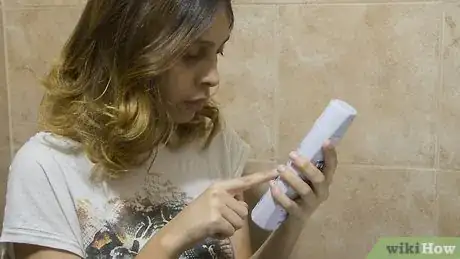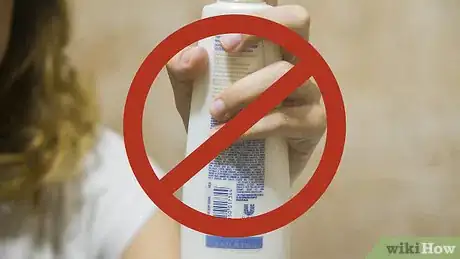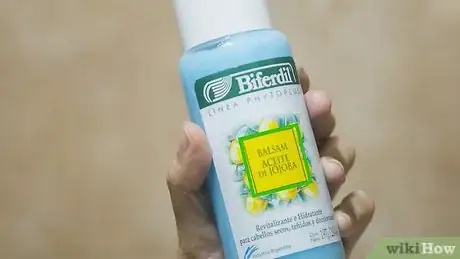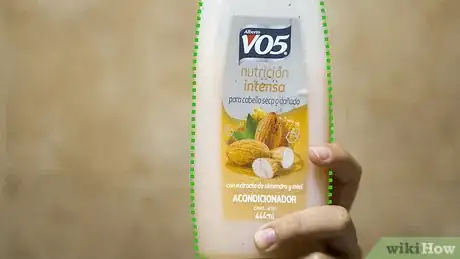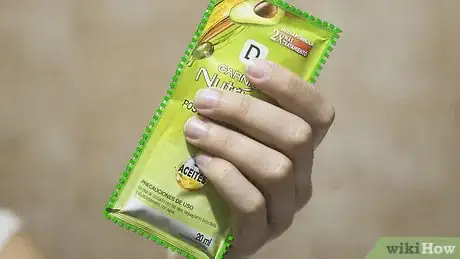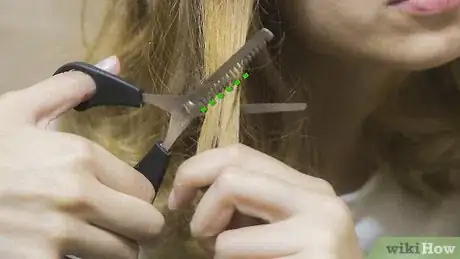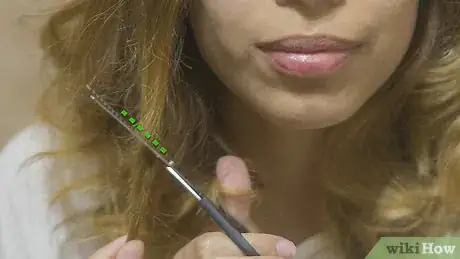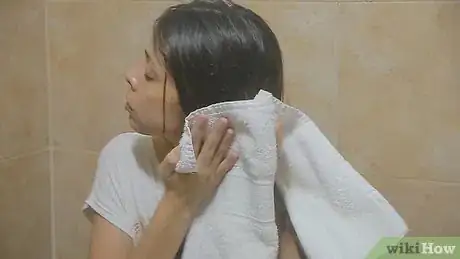This article was co-authored by Shun Pittman. Shun Pittman is a Master Cosmetologist, Author, Owner, and Founder of Corps d’Elite Salon and Corps d’Elite Beauty. With over 25 years of international experience, she is dedicated to and specializes in providing luxury salon services to all hair types and textures and every skin tone and shade. Her services include hair conditioning treatments, cutting, coloring, styling, extensions, and makeup application. Shun has experience working with, coaching, training, and mentoring beauty professionals from multiple companies including L'Oréal, Wella, Matrix, Paul Mitchell, Redken, Big Sexy Hair, and Toni & Guy. She is also a host for national and local media outlets and her work has been featured in The Washingtonian, The Cheddar Network, and WJLA Good Morning Washington's Beauty and Fashion Police segments. Shun is the author of “50 Things Your Hairdresser Wants YOU to Know (and a few things we don’t...)".
There are 12 references cited in this article, which can be found at the bottom of the page.
This article has been viewed 143,026 times.
Unless you're a member of an '80s tribute hair band, you probably don't want hair that's too poofy. Many of the cleaning and styling products on the market contain synthetic chemicals that can damage your hair and make the frizz worse. The good news is that you don't have to live with bad hair. If you use products with the right ingredients and take proper care of your hair, you can tame the frizz and look gorgeous every day!
Steps
Washing Your Hair
-
1Avoid sulfates. Check your shampoo for sodium laureth/lauryl sulfate or ammonium laureth/lauryl sulfate, especially if your hair is naturally curly. These ingredients dry out the hair terribly, making your hair puffier and bigger. If you can't find any shampoos that don't have these ingredients, look for shampoo bars, which are sulfate-free.[1]
-
2Avoid using silicone. Silicone-based ingredients build up on the hair, and only drying sulfates remove them. Any ingredient that ends the suffixes -cone or -xane is a silicone. Some common ones are dimethicone, cyclomethicone, and amodimethicone. However, amodimethicone is a lot easier to remove than some others.Advertisement
-
3Look for natural ingredients. Don't go by names alone. Many shampoos and conditioners that are marketed to combat frizz contain sulfates. Opt for moisturizing ingredients. Some good choices include:[2]
- Aloe vera
- Grape extract
- Avocado oil
- Olive extract
- Shea butter
- Basil
- Hibiscus
-
4Use a good moisturizing conditioner. Always use conditioner after using shampoo. Follow the ingredients on the bottle. Some conditioners are formulated to be left in the hair, while others should be rinsed out after a few minutes.[3] Good moisturizing ingredients include:[4]
- Macadamia oil
- Jojoba oil
- Coconut oil
- Argan oil
-
5Use a hair mask. Apply a deep-conditioning hair mask once a week. Look for oil-infused masks to fight frizz. This is especially important if you live in a hot and/or humid climate, since heat has significant drying effects on the hair.[5] Look for hydrating ingredients such as:
- Shea butter
- Glycerine
- Proteins
- Fatty acids
- Any kind of natural oil, such as coconut oil, lavender oil, or jojoba oil
Cutting Your Hair
-
1Have your hair cut with thinning shears or a razor. Have a skilled hairdresser do this. Thinning tools should only be used on the ends of your hair to prevent excess weight at the bottom.[6] Your hair dresser should only use thinning shears on dry hair or a razor on wet hair. If they deviate from this rule, they'll damage your hair and actually cause more frizz than you originally had.[7]
-
2Have your hair cut in long layers. Poofy hair should be at least shoulder-length to weigh down the frizz. Layers prevent your hair from belling out at the bottom. Make sure your layers start between your chin and your lip. From there, they should angle to the back of your head.[8]
-
3Have your hair trimmed regularly. Do this about every eight weeks. Regular trimmings will remove any split ends, which make your hair look even frizzier. If your hair tends to dry in the winter months (or in the summer if you live in an arid climate), get your hair trimmed more often, about every six weeks.[9]
Styling Your Hair
-
1Detangle your hair with a wide-tooth comb. Do this while your hair is still wet. You could even do it while you're in the shower. Combing or brushing dry hair will only worsen the frizz.
- Combing a spray-on detangler through your hair helps to remove stubborn tangles. You can buy many different brands in department stores or from your hairdresser. Just remember to avoid sulfates.
-
2Use a smoothing serum. Choose the formula that's right for your hair. If you have coarse or thick hair, look for a serum with Argan, Amla, Camellia, and/or Murumuru oil. These hydrating oils are especially helpful for dry hair. If your hair is curly or wavy, choose a serum with coconut and gardenia oils. For hair that's normal to oily, apply the serum only when your curls start to feel dry or frizzy.[10]
-
3Combine blow-drying techniques. If your hair is straight or wavy, set your hair dryer on a medium setting without any attachments (“rough drying”) until it's about 80 percent dry. If your hair is very curly, rough-dry until your hair about 70 percent dry. Add a nozzle or diffuser to complete the drying cycle.[11]
- Consider buying a high-voltage ionic blow dryer. This will help to tame stubborn frizz as you dry your hair.
-
4Air dry your hair. Too much heat can damage your hair and make your frizz worse! Let your hair air dry whenever possible. Use a soft-textured towel to blot (not rub) the excess water out of your hair. This will reduce the amount of time it will take for your hair to dry completely.[12]
- Avoid touching your hair while it's drying. Touching it will make it frizzy. Plus, it will make your hair expand.
-
5Flat-iron your hair. Choose a ceramic flat iron. It's less expensive than titanium and other coatings. Even better, it flattens your hair at a lower heat, which is better at taming frizz. Most ceramic flat irons use ionizing technology, which seals your hair cuticles and actually neutralizes poofy hair.[13]
-
6Tame bed head with a topknot. Flip your head upside down. Collect your hair at the top of your head, and tie it in a ponytail. Twist your hair into a loop, and pin it in place at the top of your head. This will keep wild fly-away hair under control.[14]
Community Q&A
-
QuestionHow do I MAKE my hair go poofy?
 Community AnswerCheck out this article at wikiHow: https://www.wikihow.com/Make-Your-Hair-Poofy It seems to offer helpful tips!
Community AnswerCheck out this article at wikiHow: https://www.wikihow.com/Make-Your-Hair-Poofy It seems to offer helpful tips! -
QuestionHow do I get rid of poof in my hair?
 Community AnswerYou can use serum or coconut oil, which is especially good for frizzy hair.
Community AnswerYou can use serum or coconut oil, which is especially good for frizzy hair. -
QuestionMy hair is really poofy and knotty, nothing works for me. How do I untangle my hair and make it straighter without damaging it?
 Community AnswerIf your hair is extremely dry, then you might be washing it too often. If this is your natural hair type, then just try and brush it out every day, starting at the ends. Hair masks can help make your hair less frizzy. I use an egg hair mask and it works great. Mayonnaise is a good substitute. If you don't already, try using a straightening conditioner, and make sure to use leave-in conditioner after washing your hair.
Community AnswerIf your hair is extremely dry, then you might be washing it too often. If this is your natural hair type, then just try and brush it out every day, starting at the ends. Hair masks can help make your hair less frizzy. I use an egg hair mask and it works great. Mayonnaise is a good substitute. If you don't already, try using a straightening conditioner, and make sure to use leave-in conditioner after washing your hair.
Warnings
- Avoid styling your hair with too much heat too often.⧼thumbs_response⧽
- Avoid setting the blow dryer on high because having it too hot will damage your hair and dry it out even more.⧼thumbs_response⧽
Things You'll Need
- Shampoo with anti-frizz natural ingredients
- Moisturizing conditioner
- Hair mask
- Wide-tooth comb
- Soft-textured towel
- Hair dryer with diffuser
- Ceramic-plated flat iron
- Spray-on detangler
- Styling serum
References
- ↑ http://www.motherearthliving.com/health-and-wellness/natural-beauty/natural-shampoo-alternatives-zmez13mjzmel?pageid=2#PageContent2
- ↑ http://eluxemagazine.com/beauty/top-5-organic-shampoos/
- ↑ Shun Pittman. Master Cosmetologist, Global Salon Educator & Author. Expert Interview. 16 June 2021.
- ↑ http://www.elle.com/beauty/makeup-skin-care/tips/a11/oil-for-beauty/
- ↑ http://www.cosmopolitan.com/style-beauty/beauty/how-to/a7073/protect-hair-from-humidity/
- ↑ http://www.huffingtonpost.com/allure-magazine/the-12-most-annoying-thic_b_6894362.html
- ↑ http://www.allure.com/story/thinning-shears-hair-damage
- ↑ http://www.cosmopolitan.com/style-beauty/beauty/how-to/a7073/protect-hair-from-humidity/
- ↑ http://www.huffingtonpost.com/ben-skervin/winter-haircare-tips_b_4421634.html
- ↑ http://www.huffingtonpost.com/2015/06/15/the-best-hair-serums-dry-frizzy-hair_n_7564398.html
- ↑ Shun Pittman. Master Cosmetologist, Global Salon Educator & Author. Expert Interview. 16 June 2021.
- ↑ http://www.marieclaire.com/beauty/hair/how-to/a94/hair-frizz/
- ↑ http://www.naturallycurly.com/curlreading/kinky-hair-type-4a/are-you-using-the-best-flat-iron-for-your-hair-type/
- ↑ http://www.allure.com/gallery/how-to-deal-with-thick-hair
